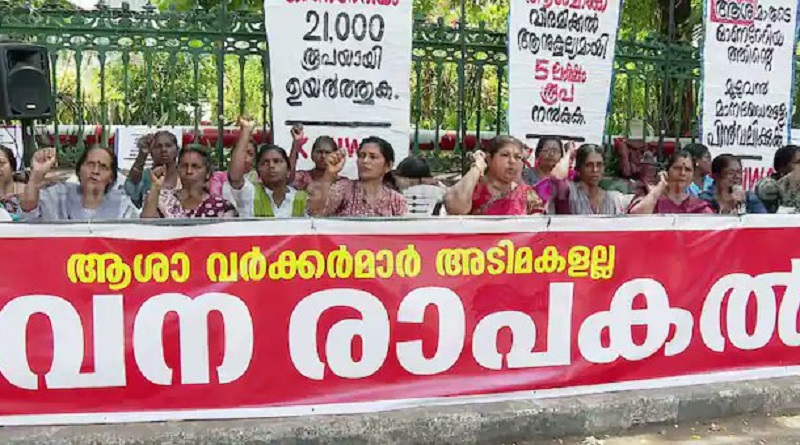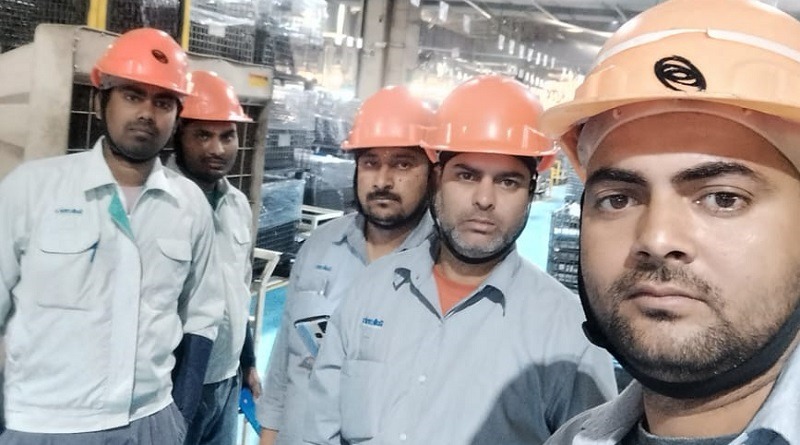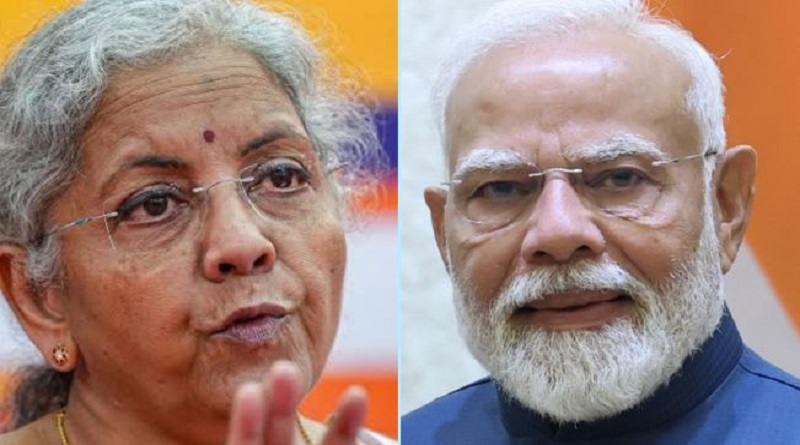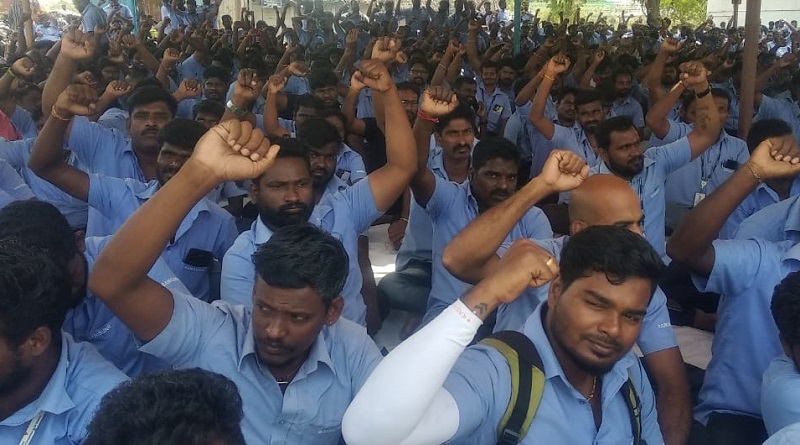The historic railway strike of 1974 lasted for 20 days, Lakhs of employees were dismissed in one fell swoop
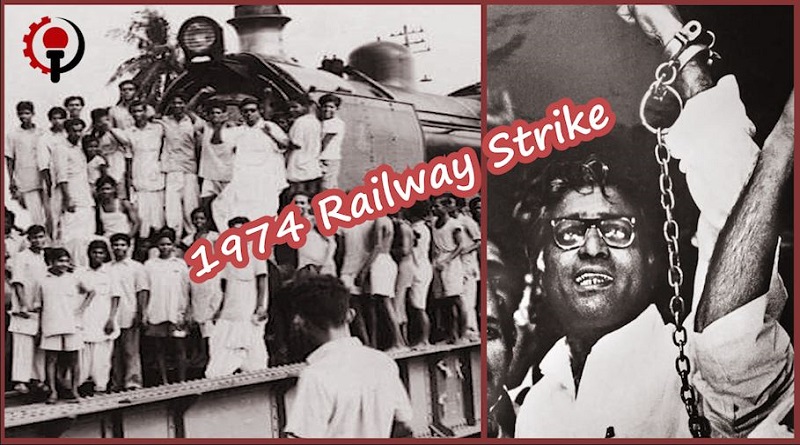
By Harsh Thakor
One of the most intensive strikes in the history of labour movements anywhere in the world took place in India 50 years ago, on May 8th 1974 when workers of the Indian Railways struck work for 20 days, demanding better working conditions and higher wages.
The strike was led by George Fernandes who acted as the President of the All India Railwaymen’s Federation, one of the two unions recognised by the Railway Board along with the National Federation of Indian Railwaymen (NFIR).
The Indian Railways strike of 1974 continues to shimmer almost unprecedented deeds of the heroism of ordinary railway workers, their families and those who with death defying courage supported them against the merciless might of the Indian state.
The most widespread and glorious revolt by the working class in independent India has received scant attention from labour historians. Scenario reminiscent of David conquering the Goliath, with 2 million workers backed by seventy lakh persons, resisting like a boulder withstanding the fiercest of gales ,exhibiting relentless spirit in heights rarely scaled.
This was arguably last of the classic general strikes in India, and certainly the last general strike in the railway industry.
Throughout year of 1973 the mood of the working people had become inclined to the left. Significantly, vital sectors of economy, the infrastructure and logistical industry in particular, underwent more unrest and work stoppages, with consequences spreading like wildfire.
- अंग्रेज़ों के ख़िलाफ़ 1907 की वो रेल हड़ताल जब कोई भी ट्रेन स्टेशन तक नहीं पहुंचीः इतिहास के झरोखे से-1
- कानपुर से लेकर कोलकाता तक तूफ़ानी मज़दूर हड़तालों का साल 1935-36 : इतिहास के झरोखे से-7
#OtD 8 May 1974, the national railway strike in India started. 1.7 million workers went on strike, but were brutally suppressed by Indira Gandhi's govt. It lasted until ‘til 27 May and was called off. Here's more info on India's mass struggles in the 70s: https://t.co/xHAGVNkZAe pic.twitter.com/eiDkI84yWr
— Working Class History (@wrkclasshistory) May 8, 2022
Demand
The rebellious mood of the workers struck turbulence to authority, law, and order. The strike emerged in the backdrop of prices soaring of foodgrains, edible oil, and Kerosene. It had a telling effect on the very ‘lifeline’ of the Indian economy.
The strike demanded a need-based minimum wage, social security, such as food, the formalisation of jobs, an eight-hour daily work limit, protection to check escalating prices and the right of railway workers to dissent and negotiate.
The chief discontent of the workers was rooted in the British-era condition whereby their work was classified as “continuous”.
This forced loco workers to be on duty as long as a train was running. Often, the duration lasted several days at a stretch.
To start with, the strike was victorious with workers and their families squatting on the tracks to block the trains running.
What shook the government even more was when electricity and transport workers as well as taxi drivers in Mumbai joined the protests.
Eventually the strike lasted only 20 days but it’s impact was felt for decades to come since it was at this very juncture that the first seeds of the Emergency were planted.
- 1925 की रेल हड़ताल जब मज़दूरों के खून से सफ़ेद झंडा लाल हो गया : इतिहास के झरोखे से-5
- कानपुर से लेकर कोलकाता तक तूफ़ानी मज़दूर हड़तालों का साल 1935-36 : इतिहास के झरोखे से-7
Formative developments
Workers waged a prolonged struggle for securing an eight-hour working day on par with other government staff for a while.
Between 1967 and 1974 there had been four such strikes but the one in 1974, supported by over 70 percent of the railway staff, was the most unique..
Now many rail workers having lost faith with their recognized unions’ failure to protect their rights formed independent, category-based unions, such as the Loco Running Staff Association.
During the 1960’s unrest escalated amongst railway workers on issues of low wages, harsh working conditions and long hours of work. The railway board remained completely apathetic, instilling frustration and alienation within workers.
This brewed a collective and independent resistance from workers to construct independent category unions, like the loco running staff union. In August 1973, after prolonged struggle, it procured demands of mass sick leaves, work to rule and work to designation.
It reduced working hours from 14 to 10. This development was the breeding ground for the blooming of the strike in 1974.
The two railway Unions affiliated to the railway board, the All India railwaymen’s federation and the National Federation of Railwaymen opposed negotiation of workers with the board, and did not morally wage struggles for rights of workers.
The government was embarking on a scheme on introducing electrical engines to replace Steam engines, which proved disastrous to the railway transport system, with further production of steam engines stopped.
Huge amounts of dumped coal and steel products lay dumped in coal fields and factories. Now the government transferred the burden of responsibility to the railwaymen, with their sheer negligence on the verge of being exposed.
They purposely sowed the seeds for the turbulence of railwaymen, leading to a strike. On the filthy plea of an impending strike, it cancelled almost 400 passenger trains, diverting all engines.
On April 20, 1974, 1,000 women and children in then Madras organised a rally to the divisional headquarters of the Indian Railways raising slogans and gave a memorandum containing their grievances on the chief station officer.
At Trichy, 1,800 women and children who comprised 20% of the residents of the Trichy railway colony took out a similar morcha (procession).
At Madurai, 1,000 women rallied to gherao (encircle) the divisional superintendent to force him to stop down to their memorandum of grievances.
At Guntakal, 400 women, including women in purdah (veils), rallied to imbibe consciousness among the general public.
All this happened on the same day that the railway union leadership sat on the negotiating table with the authorities at Rail Bhavan in New Delhi.
- 1928 में ताबड़तोड़ हड़तालों से 35 लाख कार्य दिवसों का नुकसान हुआ : इतिहास के झरोखे से-12
- मुंबई में भारतीय मज़दूरों की प्रथम राजनीतिक हड़ताल की राजनीतिक और सामाजिक पृष्ठभूमिः इतिहास के झरोखे से-10
Children using Delhi railway station as playground in May 1974 due to railway strike which lasted for almost a month pic.twitter.com/rwGAEYDYjh
— Guruprasad (@guruprasad_gp) May 31, 2015
Impact of Scheduled Castes
The scheduled caste community of Mysore played an important role in knitting scattered forces for the railway strike. Since 1971, there had been a vacancy for the post of assistant superintendent in the railways’ machine shop in Mysore which was reserved for Scheduled Caste candidates from the locality.
Defiantly the authorities betrayed the SC applicants by filling the post with non-local and non-SC candidates under ad hoc appointments for far too long.
The assertive Scheduled Caste workers who waged a relentless battle for their right to education, work, protest, and equality left inextinguishable hoof prints of their role to the blossoming of the historic May 1974 strike.
When M.V. Vardharajan, an ad hoc appointee, departed in September 1973, the vacancy was transferred to the Efficiency Cell in then Madras and remained unfilled till March 1974 despite available local SC candidates at the Mysore workshop.
On March 30, 1974, Radhakrishnan, a non-SC, non-local candidate, was appointed to the post ad hoc. This sparked a spontaneous protest from the Scheduled Caste community.
Almost the entire Mysore workshop staff from all social categories joined the protest, garnering high striking capacity to the mobilisation for the strike that would be called in May.
Babu Ram from the All India SC/ST Railway Employees Association announced that the ‘economic battle’ that the SC community would face during the strike would promote their standard of life by strengthening the education of their children. He appealed to his community to participate with their two million fellow railway workers.
Retaliatory Actions by Labour
In Phulera, Rajasthan, a railway officer named L.A. Bhatnagar noticed on April 20, 1974 that the railway workers were wearing badges that read ‘Mein Hartal Karunga’ (‘I will go on strike’). and retorted to tormenting the workers.
However, the workers did not relent but , ignited a huge protest. Four hundred people shouted slogans against the railway officers’ anti-labour attitude, which integrated with slogans for the general strike.
The neighbourhood pooled in and the unions garnered more people which led to the total stoppage of work at Phulera, including carriage and wagon work.
On March 16, 1974, in Jhansi, Uttar Pradesh, 16 on-duty employees, probably casual labourers or Class IV regular employees, were arrested by the Railway Protection Force (RPF) for crossing lines at Jhansi Railway Station.
When labour leaders protested, the RPF threatened to open fire. The workers of the Carriage and Wagon as well as Signal and Telecommunication departments stopped work and demanded the immediate release of their fellow employees.
The strike spread like wildfire to other departments in Jhansi and when two mail trains were delayed, it penetrated even further into wider networks.
Slogans against the RPF rung in the canteens during meal hours. The officer in charge of Jhansi station was gheraoed; a member of parliament was forced to come with the civil authorities to plead for peace..
Casual labourers and Class IV employees successfully thwarted the RPF and rail officers. By means of integrating into such a collective and cohesive unit of the ordinary that the railway workers shattered the myth of the unconquerable.
Repression and Emergency
The government was embarking on a scheme on introducing electrical engines to replace Steam engines, it purposely sowed the seeds for the turbulence of railwaymen, leading to a strike.
On the filthy plea of an impending strike, it cancelled almost 400 passenger trains, diverting all engines for purpose of products like dumped coal and other essential commodities.
The Indira Gandhi led Congress govt organised most brutal repression. Family members and even women folk were brutalised in a savage manner Deploying forced labour to keep the kitchens burning, forced labour was used to propel the railway wheels. The BSF, CRP and police recruited higher goondas to mount atrocities on striking railway employees and their family members.
The strike led to merciless government action with the Border Security Force (BSF), Central Reserve Police Force (CRPF) and the Provincial Armed Constabulary (PAC) deployed to crush the protests.
Thousands of workers were arrested under the draconian Defence of India Rules and the Maintenance of Internal Security Act (MISA) and others were summarily dismissed from service.
Fernandes along with many of the leaders was arrested on the night of May 2, 1974 a clear indication that the government of Indira Gandhi was reluctant to negotiate.
The repression with which the state moved to quell the movement was a precursor of events that would shape out a year engulfing the country when Emergency was declared.
In ending the strike, the railway men bowed to the position of Mrs. Gandhi, who decided to imprison thousands of rail workers —the figures range from 20,000 to 50,000. Mrs. Gandhi had declared that the strike was “illegal” and that the Government would not bargain with the rail union until the walkout ended.
Railway workers faced harsh consequences in the aftermath of the strike. 30000 permanent staff were dismissed, 50000 casual workers working from 5-20 years dismissed, 20000 workers prosecuted on criminal charges, 10 lakh permanent workers treated as new recruits, etc.
(Harsh Thakor is freelance journalist. Thanks information from ,’Proletarian Era ‘of June 1974, Sundeep Khanna in Backstory, New York Times of May 1974 by Bernard Weinraub and Jyotishman Mudiar in the Wire in May, 2021)
(The views expressed in this article are the author’s own and do not necessarily reflect Workers Unity editorial stance.)
Do read also:-
- A Student Intifada: Massive protests against Israel war on Palestinian engulf America
- Labour in ‘Amrit Kaal’ : A reality check
- Discovering the truth about Demonetisation, edited and censored, or buried deep?
- Class Character of a Hindu Rashtra- An analysis
- Gig Workers – Everywhere, from India to America, from delivery boys to University teachers
- May Day Special: Working masses of England continue to carry the spirit of May Day through the Year
- New India as ‘Employer Dreamland’
- Urgent need for reinventing Public Sector Undertakings
Subscribe to support Workers Unity – Click Here
(Workers can follow Unity’s Facebook, Twitter and YouTube. Click here to subscribe to the Telegram channel. Download the app for easy and direct reading on mobile.)
